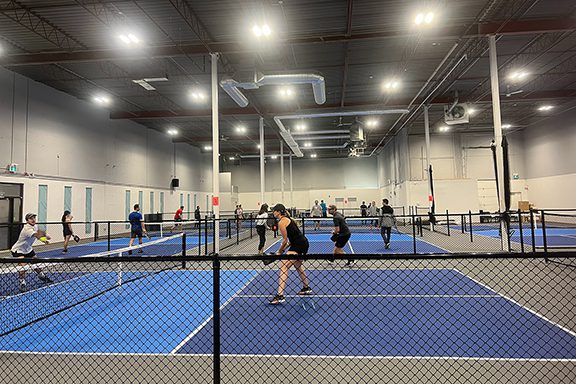Noise Control Design Strategies for Indoor Pickleball Courts

Designing Indoor Pickleball Facilities for Acoustic Compatibility
As pickleball continues to grow in popularity across North America, commercial properties are increasingly converting underutilized spaces into vibrant indoor sports and fitness facilities. While indoor pickleball court facilities can add significant value and attract diverse users, they also present unique acoustic challenges. The energetic sounds from paddle-to-ball impacts and lively player chatter can potentially disturb adjacent commercial and office spaces. For commercial developers, property managers, and architects, addressing these noise issues through effective acoustic design is essential to maintain tenant comfort and satisfaction, protect property values, and ensure a harmonious environment for all occupants.
Noise and the Popularity of Indoor Pickleball in Mixed-Use Commercial Spaces
Integrating high-energy recreational spaces like pickleball courts with quiet commercial and/or office environments requires a keen understanding of the acoustic challenges involved. One of the main issues is the transmission of impulsive sounds—such as the sharp impacts from pickleball play—through shared walls. Additionally, large group activities, such as tournaments or youth camps, can raise overall noise levels more significantly. These challenges are compounded by the presence of flanking paths, where sound can leak through gaps, around walls, or through unsealed penetrations, bypassing even the most robust acoustic barriers.
Key Acoustic Concepts for Noise Control
Understanding a few key acoustic principles is vital when designing spaces that host indoor pickleball courts adjacent to noise sensitive uses (offices, daycare, retail, etc.).
Noise Criterion (NC):
The Noise Criterion, established by ASHRAE, serves as a benchmark for acceptable background noise levels. For office spaces, an NC rating of 30 to 35 is recommended, corresponding to ambient levels of roughly 35 to 40 decibels A-weighted (dBA). Maintaining this noise level in adjacent offices is crucial for ensuring a quiet working environment.
Sound Transmission and Isolation Ratings:
Measurements such as the Sound Transmission Class (STC) and Noise Isolation Class (NIC) evaluate how well a wall or partition can block airborne sound. While STC ratings provide laboratory-based performance metrics, NIC ratings account for real-world factors such as sound leakage or flanking. A higher rating indicates better sound isolation, which is essential for minimizing disruptive noise from adjacent pickleball courts.
Reverberation Time:
Reverberation time, or RT60, measures how long it takes for sound to decay by 60 decibels in a space. In large, open areas with hard surfaces—typical of repurposed warehouse environments—reverberation times can exceed three seconds. This prolonged reverberation can amplify noise, making speech intelligibility very poor and making it more challenging to maintain a quiet adjacent office environment.
Approaches to Acoustical Challenges of Indoor Pickleball Courts
To address these acoustic challenges, a comprehensive noise control strategy is necessary at the onset of fit-out design. One effective approach is enhancing the demising wall that separates the pickleball courts from the adjacent noise sensitive uses. Focusing improvements on the mid frequency 500-2,000 Hz range, where pickleball impact noise is most pronounced, will have the greatest benefit.
Another critical aspect is sealing potential flanking paths. Gaps around pipe penetrations, ductwork, or where walls meet floors and ceilings can undermine even the best-designed walls. High-quality acoustical sealants applied to these areas can significantly reduce unwanted noise leakage, ensuring that sound remains confined to the designated sports area.
Advanced Acoustic Design Strategies for Adjacent Tenant Comfort
Beyond wall enhancements, reducing the overall reverberation in the pickleball courts area is essential. Large, reflective spaces require acoustic treatments such as wall panels, ceiling baffles, or suspended ceiling clouds. These treatments absorb sound energy, shortening reverberation times and reducing the build-up of disruptive noise. By strategically placing absorptive materials, designers can not only improve the playing environment but also minimize the transmission of sound to adjacent office areas.
Maintaining target ambient noise levels in office spaces might also involve background masking techniques. For instance, low-level HVAC noise, when carefully designed, can help blend intermittent pickleball sounds with the overall ambient noise without exceeding comfort thresholds.
Future-Proofing Your Commercial Property Investment
As multi-use facilities evolve, it’s important to consider future expansion or reconfiguration plans that might affect acoustic performance. Flexible, modular acoustic solutions allow for adjustments as the facility’s usage changes over time. Modern acoustic treatments are available in a variety of designs, enabling seamless integration with the building’s aesthetic while providing robust sound control. This forward-thinking approach not only safeguards the current tenant experience but also enhances the long-term value of the property.
Conclusion
Integrating indoor pickleball courts into commercial properties offers exciting opportunities to maximize space and attract diverse users. However, without careful initial acoustic planning, the noise generated by these recreational indoor sports and fitness centers can disrupt adjacent office environments. By working with an experienced acoustical consultant at the design stage you can ensure that your building’s indoor pickleball courts facility will deliver win-win business success without compromising neighboring tenants’ peace and comfort.

